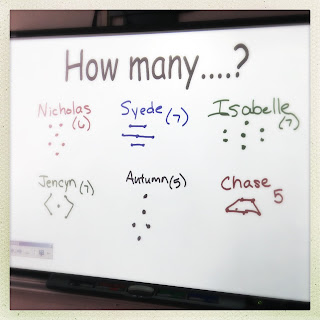I do want to talk a bit about how I structure the opening routine to our class time. The routine I am describing is what we use Monday-Thursday, because we open Friday by checking the weekly homework instead. This routine will last about 2-3 more weeks. At that point, I will introduce My Favorite No as the Wednesday-Thursday opener and this will remain as our Monday-Tuesday opener for the remainder of the year.
The genesis of this idea came from a conversation that I had with Elizabeth Statmore at TMC16 about class routines and students lacking fluency with basic facts. I know that I need to help students build that fluency but I am pretty adverse to anything that feels like a timed test. This compromise has just the right balance of speed encouragement and pattern reinforcement to meet the needs of my classroom. Students arrive and immediately collect blank multiplication charts for their team. The moment the bell rings, I start the musical accompaniment. I found a perfect website from which I chose our song, Little Hero. I assumed I'd need to change up the song every nine weeks or so to keep from going insane, but I actually managed to find a song that I can listen to five times a day and not want to gouge my ears out.
When the music starts, the students spend three minutes completing as much of the chart as they can in the allotted time. This not only has them practicing the patterns in repeated addition, but it gives me time to complete the housekeeping tasks that often delay the start of a class. By the time the music stops, students are settled and we are all ready to go.
At this point, I do have them look over their charts and record one fact that they either missed or hadn't gotten to. A corrected multiplication chart is on the board for this which helps us move smoothly into the next part of the opener routine, which involves the day's date:
The questioning typically runs as follows:
- Can someone read to me what this date says? [Student responds.] - This is an opportunity to explore new conventions of writing operations (multiplication without a symbol and division as a fraction) as well as reviewing concepts that we've covered (exponents, absolute value, etc.).
- What is the value of this expression? [Choral response.]
- [Move to the Smartboard multiplication chart.] Okay, so today is _____? Can someone tell me where I might find that product on a multiplication chart? [Student responds.]
- Using the commutative property, where else might I find it? [Choral response.]
- This process repeats until the students agree that we have exhausted all facts. I usually reitterate that there are other ways to get a product of _____, but that it would mean using negative values or fractions and we are limiting ourselves to whole numbers on this chart.
- So, how many factors does _____ have? [Choral response.]
- And they are? [Choral response.]
- Which makes this number....? [Pause time and then a choral response of "prime" or "composite."] We will add on the idea of a perfect square when we get there and I usually make a little fuss when it is a perfect square day.
The entire process goes pretty quickly once I've taught it but it allows me to review several concepts in a very abbreviated time. Here is a picture of what the result looks like:
Other than that, the day was pretty simple. We didn't have SPL today due to our PLC period and we used our 9th period to distribute test scores and data before students left.
Tomorrow will be our first graded assessment so hoping for good results. :)




































